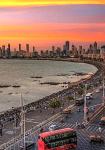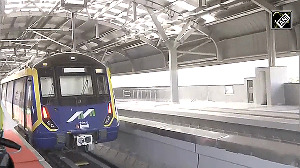India and China, the two most ancient civilizations of the world, enjoyed remarkably wonderful relations in the first millennium since the birth of Christ. Even in the second millennium, relations between the two nations have been quite co-operative and amicable.
In the history of more than 2,000 years between the two countries, except a few years owing to the border clashes, the ties between the two nations has been quite satisfactory.
India was one of the first countries to establish diplomatic ties with the Peoples Republic of China on April 1, 1950 and in the 50s, the relations between the two countries was marked with the bonhomie of 'Hindi-Chini Bhai Bhai'.
Now the two countries have once again come closer with the term "Chindia" gaining currency in the political and social circles of the two countries. So it surprising to find that that Hu Jintao will be only the second Chinese head of state to visit India, while so far only two Indian head of states have visited China, the last in June 2000 by K R Narayanan.
The main agenda of Hu Jintao's visit to India will not be settling political or military issues but to spur economic and trade relations. The Chinese ambassador to India Sun Yuxi has not only reiterated the Chinese claim to Tawang but for the whole Arunachal Pradesh. The Tawang issue has been comprehensively talked by Chinese military personnel and even some academicians. But since this will be Hu's maiden visit to India; he will be not naïve enough to attach any high significance to Tawang or Arunachal.
Economic progress and favorable trade ties are close to the Chinese politicians as their chief economic architect, Deng Xiaoping had shown that only through economic development and raising the life standard of their citizens could the Communist Party of China rule the country for good.
During his visit to India, Hu is expected to sign more than 10 economic and trade agreements. The agricultural ministries of both nations have also agreed to that for the first time, Indian Basmati rice will be exported to China. The Chinese are also very keen to re-start the export of Chinese garlic to India, which was blocked by India since January 2005 due to the discovery of some black fungus (Basilli Illius) in their garlic.
Sino-Indian trade has increased by more than 40 per cent this year and is expected to touch the $20 billion mark (about Rs 90,000 crore), compared to below $1 billion (about Rs 4,500 crore) in 1994. The benchmark of $20 billion was initially supposed to be achieved in 2010, but was revised to 2008 during Premier Wen Jiabao's visit to India in April last year. It is now expected to be achieved this year. China is slated to become India's largest trading partner, surpassing the US in a few years time.
Despite major fundamental differences in their political and social systems, both countries have acquired international attention as rising economic powers due to open market economy-oriented reforms. China has quite meticulously evolved a grand vision and strategy for transforming itself into a major 'Global Economic Power' by 2020. The Indian economy has too has been growing at an annual rate of more than 8.5 per cent, and double-digit growth is achievable mainly due to the impulses generated by its entrepreneurs especially in the IT and biotechnology related knowledge-intensive services and industries.
As the two strategic partner countries, India and China could eschew competitiveness and become co-operative nation in the field of petroleum exploration bidding in third countries, as we successfully did in some African nations. There is also huge potential for co-operation in IT and IT-enabled industries as well as on major negotiations as developing agricultural countries at the World Trade Organisation and other multilateral global organizations.
The two nations also have huge growing complementariness in production and consumption structures and in mutual trade bilaterally. There is also a big scope for joint business ventures for exploiting world consumer markets. There is a need for setting up strategic alliances at commerce and business level with facilitative role for the governments of both the countries.
Apart from visa relaxation for Chinese entrepreneurs and tourists, Hu Jintao will also demand more assurances from Indian leaders about a more congenial environment for Chinese companies to invest in India. But India has been unable to shed its post 1962 mind set, and has been apprehensive about Chinese companies due to espionage and security reasons.
Hu Jintao will argue that while the Chinese have allowed more than 150 Indian companies to invest in more than 2,000 items, only 50 Chinese companies have been allowed to invest and explore the Indian market. The Chinese side has been accusing India of looking at it with old suspicious eyes, even though 2005 was regarded by both the sides as strategic partnership year for joint progress and prosperity and 2006 is the year of Sino-Indian friendship year and 2007 is to be marked as India-China friendship year.
Hu, who is also the General Secretary of the Communist party of China, has already garnered huge support from the powerful Communist parties of India, and Communist Partry of India-Marxist leader Sitaram Yechuri has been very vocal is his support for China after his return from a official visit to that country.
During his visit, Hu is also expected to suggest the establishment of a Free Trade Agreement between the two nations, which India is poised to politely decline owing to unfavorable domestic market conditions. China has been unable to establish FTA with any major countries in the world including US, EU, Japan or France and has been successful with only a few African and Latin American countries. Pakistan may sign a treaty on this during Hu's weeklong visit to the country from November 23.
India lags behind in a big way as far as economic development is concerned. China attracted about $66 billion as FDI in 2005 while India was able to attract only $5 billion (about Rs 22,500 crore). China has almost a trillion dollars as its Foreign Reserves now, while Indian foreign reserves hover around $166 billion. India's GDP is about $700 billion while China's GDP is about $ 1.723 trillion. Chinese export is more than $700 billion, constituting 6.5 per cent of the world's exports every year while Indian exports is mere $75 billion, constituting less than 0.9 per cent of the world exports.
More than 26 per cent Indian population lives below the poverty line while in case of China, it is not more than 5 per cent. More than 92 per cent of Chinese population is literate while more than 35 per cent Indians are still illiterate. Thanks to its one child policy, the population growth rate of China has been less than 0.8 while it is more than 1.7 in case of India. In Shanghai alone there are more than 30,000 skyscrapers, while there are not even 3,000 combined in all the four metro cities of India.
Thus, India has to learn a lot from China.
Dr Yukteshwar Kumar is a Professor in Chinese Studies, University of Delhi.







 © 2025
© 2025